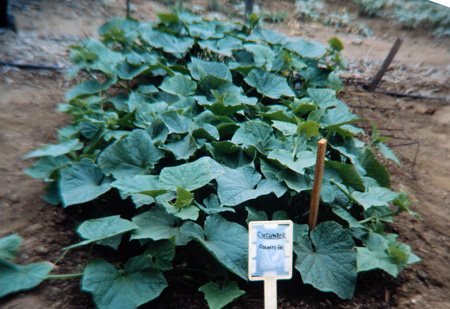Cucumber
The CUCURBITACEAE family has many forms and has been feeding the world since the beginning of recorded history. The remains of cucumbers and gourds have been found in archaeological excavations dating two centuries before Christ. Members of this family have origins in many different regions of the world. Only the cucurbita genus is thought to originate in North, Central and South America.
Squashes belong to the Cucurbitaceae family along with the melons, cucumbers, gourds and pumpkins. They are also divided into short and long maturities. The genera Citrullus and Cucumis include watermelons, cantaloupe and cucumbers (Cucumis sativus).
Most cucumbers are insect pollinated and will cross with other cucumbers and West Indies gherkins. They produce far more female flowers than they can mature. Sometimes you will find a cucumber without seeds. This has to do with the fact that cucumbers are capable of developing a fruit without fertilization (parthenocarpic).
Most hybrids and open-pollinated varieties are monoecious plants producing both male and female blossoms. Gynoecious hybrids produce only female blossoms, early and with heavy yields. They will set the first 6 - 7 blossoms and also set about a third of the crop without pollination, but need male blossoms to set the rest. Seed packets will contain a few monoecious seeds, usually dyed a different color. Plant one of these to every 5-6 of the other.
Cucumbers have some problems in our area. High humidity and warm temperatures encourage foliage diseases such as powdery mildew. As plants become stressed from disease, they produce less and less. It's best to pull diseased plants out and start new plants later. Plant seed or transplants in an area with full sun and good air circulation. Selecting disease-resistant varieties is important. Virus diseases transmitted by insects are numerous.
Cucurbitacin is the chemical compound that makes cucumbers bitter. Breeders have developed many disease-resistant and bitter-free hybrids. The amount of the compound found in the fruit is genetically controlled. If you grow one of the older varieties like 'Straight Eight' that develops bitterness in 80% of its fruit, the concentration of cucurbitacin will increase if the plant is stressed in any way. On the other hand, if one of the newer hybrids that has been developed with European or Oriental seed parents is grown, the cucurbitacin concentration is controlled (limited) genetically and water stress does not produce bitter fruit.
There are two basic types of cucumbers grown in home gardens, slicing and pickling. There are bush and vine slicers, bush and vine picklers, bitter-free, seedless and high yield types.
Slicing cucumbers come in standard, (monoecious), all female, high yield (gynoecious), seedless, two types: indoor (greenhouse) and outdoors. These require no pollination with males. The difference between this type (parthenocarpic) and the all-female type (gynoecious) is that the latter needs a male flower nearby.
Planting Dates
Coastal:
Mid-March - July
Inland:
April to July
Varieties
Varieties (catalog sources 2010:
Spacemaster, 60 days, Park and Stokes Seeds
Bush Champion, 62 days, Park Seeds
Bush Whopper, 55 days, Park Seeds
Euro-American Hybrid, vine, 45 days, Park Seeds

Standard types usually have a delayed set of fruit due to male blossoms opening first. About a week later, female flowers begin to bloom and fruit sets. If this delay bothers you, try a gynoecious (all-female) type such as Supersett, 53 days, Stokes.
Also check out ...
UC websites for the Vegetable Research and Information Center (http://vric.ucdavis.edu) and Integrated Pest Management (www.IPM.ucdavis.edu)

